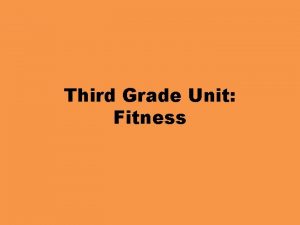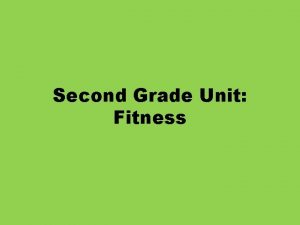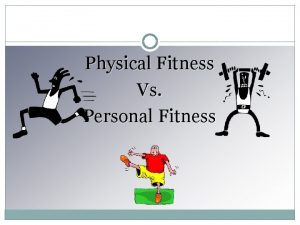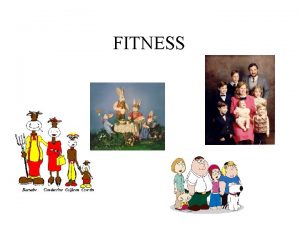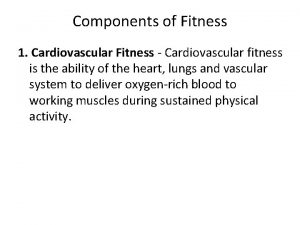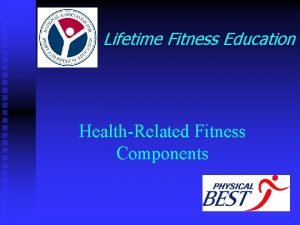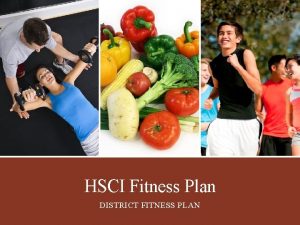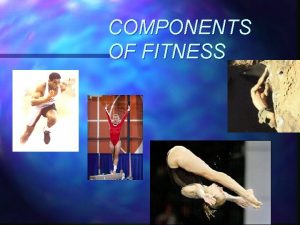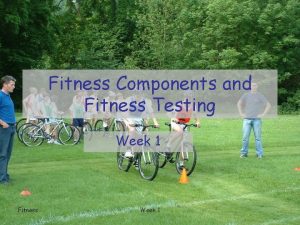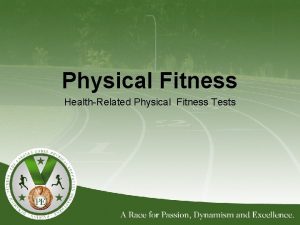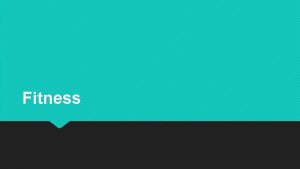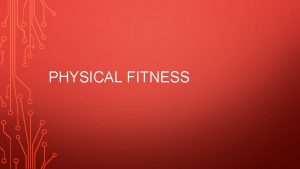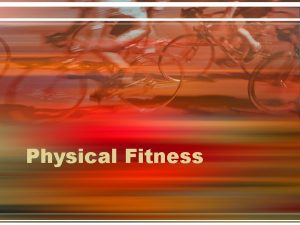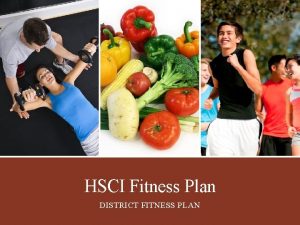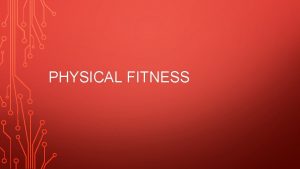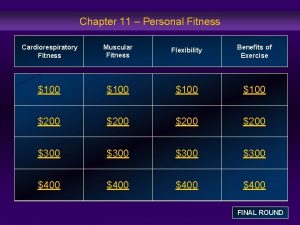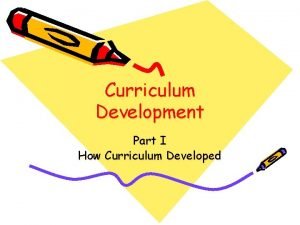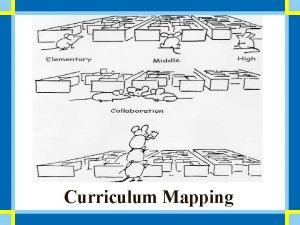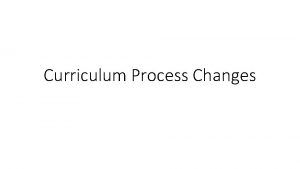Fitness Curriculum for 9 th 10 th Grade




































- Slides: 36

Fitness Curriculum for 9 th & 10 th Grade Girls Create an innovative and fun fitness regime that will challenge and motivate your students. Helen Wade

Health Related Fitness Components • • • Body Composition: cardio respiratory endurance exercises burns calories at the highest rate per minute. Resistance training builds muscle which increases metabolic rates for a greater calorie burn. Cardiovascular Endurance: running, fitness walking, aerobic dance, stair and bench run ups, basketball, swimming, cycling, water aerobics, soccer, lacrosse. Related to health of cardio respiratory system. Flexibility: stretching and yoga. Puts joints through a wide range of motion. Muscular Endurance: calisthenics, push- ups, pull- ups, abdominal curls, weight training with light weights and high repetitions. The movement of muscles without becoming fatigued. Muscular Strength: resistant training with weight machines, free weights, elastic bands, and gymnastics. Helen Wade 1

Why Heart Rate Range is Important • Cardio respiratory endurance • The most important fitness component is cardio respiratory endurance, the ability of the heart, blood vessels and lungs to deliver oxygen to the working muscles and to remove waste products during vigorous physical activity. Cardio respiratory endurance is expressed in terms of your maximal oxygen uptake, the greatest amount of oxygen that can be used by the body during intense exercise. This is the best indicator of physiological well – being. Research shows that vigorous exercise is needed to keep the heart healthy, prevent heart disease and live at the peak of health. Helen Wade 2

Determining Your Heart Rate Range • • • The target heart rate represents the intensity level at which you should exercise to produce cardio respiratory benefits. This amount of exercise (overload) is enough to condition the heart, lungs and muscles but is not overly strenuous. Monitoring intensity during a workout is done by measuring the heart rate. For fitness to occur your heart rate must be raised to approximately 60% of the difference between the resting and maximal heart rates. An increase in heart rate equal to 80% of the difference between resting and maximal rates is a reasonable upper intensity level for most exercisers. Lesson: Students will determine their Training Heart Rate Range using the Karvonen Method. Training Heart Rate (THR)=(maximal heart rate (MHR)- resting HR x intensity%= working heart rate. Resting HR = count your pulse at rest for 60 seconds. When estimating your target heart rate range, you must first establish two factors: Helen Wade 3

Heart Rate(cont) • • Your age: _____ Your resting heart rate (RHR): _____ • Use the above numbers in the following formula: A. 220 - _____ = _______________ (Your age) (Estimated maximal heart rate (MHR) B. _____ - ________ = __________ (MHR) (Resting heart rate) (Heart rate reserve) C. _____ X. 60 = ________ + _____ = _________ (HR reserve) (Lower intensity) (Resting HR) (Lower target HR) D. _____ X. 90 = _______ + _____ = __________ (HR reserve) (Higher intensity) (Resting HR) (Higher target heart rate) E. Target heart rate range is __________ to _________ (Lower target HR) (Higher target HR) Helen Wade 4

Exercise and Heart Rate • Lesson: To demonstrate how exercise affects heart rate. • What you will need: You will use stopwatch to take a heart rate count for each of these activities. Use heart rate monitors if possible. Time for 6 seconds start counting beats with a zero add a zero to the number. Beats per minute • Record resting heart rate. ______ • Take normal heart rate while sitting. ______ • Warm up by doing 5 minutes of yoga. • Take heart rate after stretching. ______ • Fitness walk for 5 minutes. • Take heart rate after fitness walking. ______ • Jog to a medium music beat for 5 minutes. • Take heart rate after jogging. ______ • Run very fast for 6 laps of the gym. • Take heart rate after running fast. _______ • Cool down to a slower music beat for 5 minutes. • Record heart rate after cool down. ______ • From this demonstration I learned that: ______________ Helen Wade 5

Body Composition/Physical Appearance Benefits • • • Reduced body fat %. Increased lean body mass. Firmer, more toned muscles. • Psychological benefits • • Enhanced sense of well-being, resulting in increased energy, alertness and vitality. Increased sense of self discipline. Reduced state of anxiety. Improvement in the quality of sleep. Reduced symptoms of mild depression Improved level in memory and learning. Feeling of relaxation. Helen Wade 6

Female body mass index norms Female body fat% norms Age 14 -24 Excellent 20% Essential fat 10 -12% Good 22% Athletes 14 -20% Fair 25% Fitness 21 -24% Poor 30% Acceptable 25 -31% Very Poor <30% Obese Helen Wade <32% 7

Why Exercise? • • • • • • Increased sense of well being and self-esteem, resulting in increased energy, alertness, and vitality. Increased sense of self-discipline Reduction in stress Improved quality of sleep Decreased level of depression Improved brain function Feeling of relaxation Weight control Suppress appetite Increase in lean body tissue More toned appearance Injury prevention Lower resting heart rate Improved heart efficiency Increased oxygen capacity of the blood Greater endurance during exercise Improved performance Reduction in blood pressure Quicker recovery to resting heart rate after vigorous activity Fewer illnesses and death due to chronic heart disease Increase in bone density Lowers risk of some cancers and diabetes Increase in flexibility Helen Wade 8

Why Do My Students Enjoy P. E. Class? • • • Have fun and participate in many different activities Enjoy socialization with their friends Stay in shape and look good Learn workouts that they can do at home and teach their parents and friends Feel fit and healthy Emphasis is on individual activity and personal goals, and to a lesser extent on competition Class is not taken over by the more skilled Learn new games and activities so all begin on a level playing field Succeed at their own level Stress that a lower score is not a reflection of their self worth I play modern music which engages the students Talk about current health and fitness research which explains the need to keep fit Helen Wade 9

Scheduling • • We participate in P. E. class four days a week, fifty minute blocks with one extended period of one hour and ten minutes. Three classes are fitness, one is sports, every other week, a fitness class becomes a health class. Extended periods are hikes, 2. 2 runs, 3 mile power walks and fitness circuit testing. Fitness testing occurs once a quarter with 1 mile, 2. 2, 1. 5 runs, 2. 2 walk, fitness circuits, portfolio check and written tests. Step aerobics, aerobics or pliometrics are usually once a week. Calisthenics, weight training, band workouts are rotated through once a week. Flexibility training once every other week. Once every 6 weeks, medicine ball workouts, balance ball workouts, fitness video’s, orienteering and kick boxing Helen Wade 10

Pre-class • When the girls walk in the gym welcome them and ask how they are. It is very important that they know you care and are interested in each one of them. Have the activity posted by the entrance so they know what they are participating in for the lesson. • Write on the board what the class will entail, student tasks and goals, which components of fitness are covered, what standard, how many calories they will burn, what their heart rate should be and how they will improve their health with this activity. • Give your students something to do as soon as they walk out of the locker room, before they officially begin class. • At the end talk about what they did, did they achieve their individual goal? Did they enjoy the class, did they achieve student tasks? Helen Wade 11

Pre-class Activity Examples Pick five activities Do all the activities Pick 2 cardio, 2 strength, 1 flexibility. • Speed jump rope 100 times • Run and touch all 4 walls of the gym • Do 10 push-ups • Do 20 hula-hoops • Toss a weight ball in the air and catch it 20 times • Try and do a handstand • Volley 6 times in a row with a partner (paddle bats) • Hold downward facing dog position for 10 seconds • Throw the fitness dice 3 times • Do 3 activities on the fitness mat • When everyone is out and moving begin class Helen Wade 12

Warm - up Fitness Activities • • • Bridge Tag: One person is a catcher, when caught stand with legs apart. Can be freed by someone crawling under legs. Set a time limit/have two catchers. Count # of people caught. Repeat with another two volunteers. • Pairs Tag: Two catchers holding hands run around the gym, whomever they catch holds hands with them and then they break off into pairs. Last girl not caught is the winner. • Tails: One girl of two puts a band in back of her shorts. Second girl must try and pull out band. Weight over feet, side to side movement. • Groups of three or four: One person stands outside the circle. Have to try and tag the person in the middle. Keep alternating the middle person. Stress side-to-side movement. • Fox and Geese: Groups of four or five. Four geese in a line, fox has to try and catch the end goose. Stress sideto-side movement. • Musical Hoops: Hoops are scattered around the gym. When music starts run around outside of the gym. When the music stops jump into a hoop, gradually keep taking hoops away until one remains. Have task cards ready when girls are out so they are not standing around. • Hoop Tag: One or two catchers. Spread hoops around the gym. Safe area inside the hoop but as soon as someone comes in you have to get out. • Workout Dice: Stand in a circle, take turns to toss the dice and see which fitness activities come up. Helen Wade 13

Fitness Activities • • • • • • Aerobics Step aerobics Pilate’s tape Yoga Calisthenics and body toning Weight training Flexibility training 1. 00, 1. 5 and 2. 2 mile runs for time Runs for fun - minimum time Hiking Fitness walks for time Fitness walks for fun with weights Circuit training Fitness tapes Body composition testing Balance ball workouts Medicine ball workouts Tag and fitness games Band workouts Pliometrics Relay races Helen Wade 14

Sample Fitness Routines • Established routines help classes flow more naturally. These are designed so that students can use them on their own outside of class and share with parents and friends. • Flexibility, Muscular endurance and cardiovascular routines are just a few ways in which you can include health related fitness. • Make sure you ask them if they have performed any routines at home, quiz them on the benefits. Helen Wade 15

Abs, and more Abs (belly fat removal) 20 min workout • • Basic crunches x 20: Knees bent in line with hips and Shoulders. Lift shoulders off the floor, elbows back, chin up. • • Basic crunches with a twist x 20 each side: Opposite knee comes up twist elbow to knee. • • Baby mobile x 60 seconds: Reach up with feet and hands for a pretend mobile above your head, sit on right hip and reach, left hip and reach. • • Crossed leg crunches x 20 each side: Assume crunch position, cross right leg over left knee. Pull chest up and bring legs towards chest. Go in and out slowly. Repeat other side. • • Bicycle slow crunches x 30: Lay on your back, bring your left knee to chest, right leg shoots out straight close to floor count 4. Repeat other side. • • Elbow plank x 20 secs: Lay on your stomach, elbows under shoulders. Body is straight and belly pushes up to spine as hips tilt under. Toe’s and elbows are touching the floor. Build up to 1 min. Helen Wade 16

Yoga Workout • • • • • • • • Mountain poses; bring hands to prayer position Raise arms overhead Standing forward bend Lunge (right foot back) Downward Facing Dog Lunge (left foot back) Standing forward Fold Stand up raise arms overhead Hands return to prayer position (Repeat) Mountain poses; bring hands to prayer position Raise arms overhead Standing forward bend Lunge (right foot back) Downward Facing Dog Plank Three counts to ground Upward Dog Downward facing Dog Jump to forward Fold Head away Mountain pose; Bring hands to prayer position Raise arms overhead Standing forward bend Lunge (left foot back) Downward Facing Dog Plank Three counts to ground Helen Wade 17

Yoga continued • • • • • • • Upward Dog Downward facing Dog Jump to forward Fold Head away Mountain pose; (Repeatx 2) Dog/Cat tilt x 3 Childs pose (count to 20) Downward Facing Dog Right Foot steps in (lunge) Warrior 1 Warrior 2 Triangle Straddle Warrior 2 Downward Dog Plank Upward Dog Downward Dog Repeat Sequence left footsteps in Baby Mobile Knees to right, arms straight chest level (Repeat to left) Legs straight (Repeat) Bicycle (hold for 5 counts each side) Meditation 7 -10 minutes Helen Wade 18

Cardio/Strength Workout • • • • • • • • Warm up Cross arms and stretch – 20 Backstroke arms – 20 Jumping Jacks – 40 Standing high kicks – 40 Head rolls – 10 Strength/cardio Walking push-ups – 10 Squat to 90 -degree angle/arms shoulder press – 20 Walking push-ups - 10 Squats and shoulder press - 20 High knees – 30 Squat thrusts -15 High knees – 30 Squat thrusts – 15 One leg up crunch – 20 Lunge back leg straight elbows squeeze back and arms straight – 20 Pendulum swings elbows back and arms straight 20 Oblique twist jumps – 40 Skater jumps – 40 Lay on mat arms above chest with weights legs come up & down straight – 20 But up crunches – 20 Squat to 90 - degrees/arms come up in a V with weights Double jump rope 40 Plank jacks – 20 Plank oblique twists – 30 Double jump rope – 40 Plank jacks – 20 Helen Wade Plank oblique twists - 30 19

Body Toning Workout Arms 20 x 3 20 sec x 3 20 x 3 Stomach 20 x 3 20 modified push-ups plank position reverse push-ups basic curls bicycle curls palates full extension stomach with arms and legs extended, sit up to touch toes and role back to floor 20 lower stomach legs up legs out close to ground 1 min. plank position on elbows Hips and bottom (repeat for each side) 20 x 3 laying on your side leg raises with rounded back. 20 x 3 knee touches ground and heel reaches up to the ceiling 20 x 3 stretch foot to ceiling and bend knee to chest/repeat 20 x 3 leg extends to the ceiling press foot 12 inches towards the ground Helen Wade 20

Body Toning Workout (cont) Quadriceps (repeat for each leg) 40 sitting on the floor leg slightly bent and extended opposite leg supporting do not lift up higher than the knee 30 bring leg towards chest and then extend towards the wall 30 press leg down then lift to the side Inner thigh 50 lay on your back full extension on both legs 50 bring legs in 6 inches and let drop 50 legs straight together and walk in place in-between each activity do 2 min. of cardio Helen Wade 21

MAYFIELD SENIOR SCHOOL PHYSICAL EDUCATION DEPARTMENT STEP AEROBIC GUIDELINES • • • • POSTURE The head should be up, shoulders down and back, chest up, abdominal lightly contracted and buttocks gently tucked under the hips. Do not hyper extend the knees or back. When stepping up, lean from the ankles and not the waist to avoid excessive stress on the spine. STEPPING UP Contact the platform with the entire sole of the foot. To avoid Achilles tendon injury, do not allow the heel to land over the edge of the platform. Step softly to avoid unnecessary high impacts. STEPPING DOWN Step close to the platform and allow the heels to contact the floor to help absorb shock. If a step pattern requires stepping a significant distance from the platform, such as a lunge step or a repeater, do not push the heel into the floor. Keep the weight on the forefoot. LEADING FOOT The leading foot changes every minute. The leading leg experiences greater musculer skeletal stress than the nonleading leg. PROPULSION STEPS Propulsion steps are when both feet are off the floor at the same time. They result in higher vertical impact forces and are considered an advanced technique. REPEATERS These are movements in which the non-weight-bearing leg repeats the movement, such as a knee lift. ARMS Master the footwork before adding the arm movement. Avoid using the arms above the shoulders for an extended period of time. This places stress on the shoulder girdle. Helen Wade 22

Yoga, The Basic Practice • • • • • Dog/Cat Tilt. Warm up sequence. Loosen and warms the spine; stretches the front and back of the body; stimulates the production of spinal fluid Childs Pose. Gently stretches the spine; rests the internal organs; normalizes circulation; provides counter stretch to the backward bends. Standing Forward Fold. Calms the nervous system; stretches the back of the legs; creates space between the spinal vertebrae. Downward Facing Dog. Rests the heart; strengthens and stretches the entire spine as well as the muscles of the shoulders; upper back and calves Mountain Pose. Teaches balance; centering; improves posture. The foundation of all standing poses. Flowing Sequence. Increases flexibility of spine and joints; trims the waist; builds heat in the body; adds sense of movement to the practice. Sequence of movements: Mountain poses; bring hands to prayer position Raise arms overhead Standing forward bend Lunge (right foot back) Downward Facing Dog Lunge (left foot back) Standing forward Fold Stand up raise arms overhead Hands return to prayer position Helen Wade 23

Yoga (cont) • • • Triangle Pose. Provides lateral stretch to spine: elongates spinal column; increase strength and flexibility of legs, hips, back; tones spinal nerves; aids digestion. Warrior 1&2. Invigorating pose; strengthens back, hips, knees and shoulders; stimulates digestion; regulates the kidneys. Straddle Forward Fold. Invigorating Pose; strengthens the back, hips, knees and shoulders; stimulate digestion; regulate the kidneys. Cobra Pose. Strengthens the back, arms and abdominals; broadens and opens the chest; improves posture. Corpse Pose. Relaxes and refreshes; allows for absorption of benefits from preceding postures; develops self awareness; regulates blood pressure; improves circulation; reduces fatigue; promotes a calm mind. Tree Pose. Stretches upper torso; improves concentration; creates a sense of balance and calm. Sun Salutation. Helen Wade 24

• • • Why Test? Using assessments and threading them through the curriculum can advance students knowledge and understanding of health and skill related fitness concepts which I hope will lead them to choosing the habit of fitness over inactivity. Evaluate personal fitness level and give motivation to continue regular exercise. Used to set goals to maintain progress towards health enhancing levels of fitness. Testing helps monitor the effectiveness of the curriculum. Feedback about personal strengths and weaknesses. Helen Wade 25

Assessment Tools • • • • Rubrics Body composition Heart rate monitors Self-evaluations Observations Written tests and quizzes Discussions Skill and fitness testing Performance evaluations (self, peer, and instructor) Fitness portfolio Oral presentation Personal log/journal Out of class physical activity homework Videoing Fitness Assessment Chart Helen Wade 26

Fitness Assessment • Name the five components of health related fitness. • How often must you exercise to improve aerobic fitness? • How long must you exercise during each exercise session to improve aerobic fitness? • How can you strengthen your muscles without using weight machines? • Name one activity that utilizes flexibility as a main component? • If you wanted to reduce the percentage of body fat, what steps would you take to safely accomplish that goal? • What is the target heart rate for a 14 -year-old girl? (The ideal heart rate at which to work out to improve aerobic endurance) • What is an activity that addresses both cardio respiratory endurance and body composition? • How often must you weight train or do callisthenic exercises? • What are the benefits of muscular strength? • Losing one pound of fat requires consuming about 3, 500 calories less than you use. Sue weighs 120 pounds and wants to lose 2 pounds in the next month without changing her food intake. She likes to run at a rate that burns 400 calories an hour. How many hours must she jog this month to meet her weight loss goal? Helen Wade 27

FLEXIBILITY FOR SPORT AND FITNESS NAME BLOCK DATE • 1. WHAT IS FLEXIBILITY? • 2. WHAT ARE THE BENEFITS OF BEING FLEXIBLE? • 3. WHAT ARE THE FACTORS THAT CONTROL FLEXIBILITY? • 4. WHAT PART DOES STRENGTH PLAY IN FLEXIBILITY? • 5. NAME THE MATERIAL MUSCLES ARE MADE OF? • 6. WHAT LIMITS RANGE OF MOTION? • 7. DESCRIBE THE OVER STRETCHING PRINCIPAL SCORE____ 7 Helen Wade 28

Portfolio • • • Why students need to keep a portfolio. A place to record student performance data, showing progress or achievement during the year. Students discuss their portfolio with parents and advisors in order to better understand their personal health. Serves as a basis for program evaluation. Involve the student in the program. Help encourage reflection of goals. Create habits of mind, organization and management. Provide feedback for self-improvement. Reflection on her own work. Have as an exhibit of her own progress through the year to share with parents and teachers. Goal setting. Being able to self-monitor, self-manage, and self-evaluate. Helen Wade 29

Physical Education Portfolio Grading Rubric Level Criteria 3 Highest level: organized, best effort, all papers included and properly filled out 2 Very high: papers are together, above average effort, most papers are filled out and included 1 Folder was turned in unorganized, minimum effort, and many missing papers 0 No folder was turned in Helen Wade Check 30

Student Activity Fitness Log Activity Time/Score Heart Rate Helen Wade Date Goal 31

Mayfield Senior School Physical Education Department Assessment Chart: Freshman Class Teacher: Mrs. . Wade Student: Block: Helen Wade 32

Fitness Assessment Norms Female 1: 5 Mile Run 2: 2 Mile Walk 1 Mile Run Fitness Circuit Age 14 -29 14 -29 Excellent A 12: 34 20: 29 31: 29 7: 29 400 Good B 12: 3413: 40 20 -2922: 30 31: 29 -33: 30 7: 29 -8: 34 400 -350 Average C 13: 4014: 45 22: 3024: 45 33: 30 -35: 45 8: 34 -9: 45 350 -280 Low D <14: 45 <24: 45 <35: 45 <9: 45 <280 Helen Wade 33

Fitness Videos • • • Tae Bo - Kickboxing Videos Jillian Michaels 30 Day Shred The Firm - Boot camp The Firm - Total Body Crunch Zumba - Latin Workout Routine Helen Wade 34

Music • I use music at some point during most classes. • Music energizes a fitness class or calms a yoga class. • Use music that is current and popular with the students. Helen Wade 35
 Benefits of skill related fitness
Benefits of skill related fitness Grade 7 physical fitness
Grade 7 physical fitness What is physical fitness test in mapeh
What is physical fitness test in mapeh Formel för lufttryck
Formel för lufttryck Toppslätskivling effekt
Toppslätskivling effekt Borra hål för knoppar
Borra hål för knoppar Gumman cirkel sång
Gumman cirkel sång Bunden poesi
Bunden poesi Anatomi organ reproduksi
Anatomi organ reproduksi Smärtskolan kunskap för livet
Smärtskolan kunskap för livet Etik och ledarskap etisk kod för chefer
Etik och ledarskap etisk kod för chefer Fredsgudinna
Fredsgudinna Typiska drag för en novell
Typiska drag för en novell Argument för teckenspråk som minoritetsspråk
Argument för teckenspråk som minoritetsspråk Magnetsjukhus
Magnetsjukhus Rita perspektiv
Rita perspektiv Jätte råtta
Jätte råtta Tillitsbaserad ledning
Tillitsbaserad ledning Redogör för vad psykologi är
Redogör för vad psykologi är Claes martinsson
Claes martinsson Romarriket tidslinje
Romarriket tidslinje En lathund för arbete med kontinuitetshantering
En lathund för arbete med kontinuitetshantering Bra mat för unga idrottare
Bra mat för unga idrottare Publik sektor
Publik sektor Mästare lärling modell
Mästare lärling modell Vilken grundregel finns det för tronföljden i sverige?
Vilken grundregel finns det för tronföljden i sverige? Vishnuismen
Vishnuismen Inköpsprocessen steg för steg
Inköpsprocessen steg för steg Förklara densitet för barn
Förklara densitet för barn Ministerstyre för och nackdelar
Ministerstyre för och nackdelar Aktiv exspektans
Aktiv exspektans Plats för toran ark
Plats för toran ark Strategi för svensk viltförvaltning
Strategi för svensk viltförvaltning Tack för att ni lyssnade bild
Tack för att ni lyssnade bild Nyckelkompetenser för livslångt lärande
Nyckelkompetenser för livslångt lärande Verksamhetsanalys exempel
Verksamhetsanalys exempel Läkarutlåtande för livränta
Läkarutlåtande för livränta





































